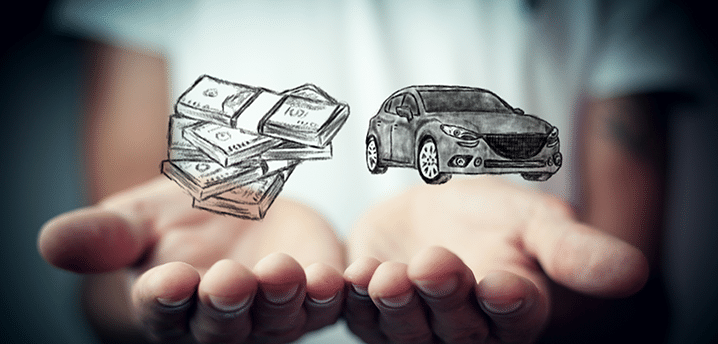Did you know you can get an auto refinance loan with cash out?
You might want to refinance your auto loan for a variety of reasons. Getting better terms now that you’ve improved your credit. Taking advantage of lower interest rates. Switching lenders.
Since you’re here, you likely know that you can refinance an auto loan. But cash-out refinancing is a lesser-known option to car loan borrowers.
True to its name, cash-out refinancing is the process of getting a new loan — and some extra cash. But is it worth it? What are the downsides? Let’s explore.
What Is Cash-Out Refinancing?
First, it’s helpful to walk through auto refinance loans. When you refinance, you essentially replace your current loan with a new loan. Ideally, you’d get better terms, like a lower interest rate and lower monthly payment.
Cash-out refinancing is similar. You take out a new loan — hopefully with better terms — to replace your existing one. Except, you borrow against the equity in your car. This allows you to get extra cash, which you can use for a variety of purposes.
For example, let’s assume your car’s value is $10,000 — but your loan balance is only $8,000. Perhaps you had a sizable down payment when you bought the car. Or maybe you recently made a big loan repayment. Regardless, you have positive equity in your vehicle.
Let’s say you qualify for cash-out refinancing and take out a $10,000 loan. Generally, you’d receive the loan as a lump sum, although that depends on the lender. Once you repay your existing loan, you’d still have $2,000 leftover. Now, you’ll make monthly principal and interest payments based on the total $10,000 loan amount.
Keep in mind that lenders typically limit the amount of funds you can borrow in excess of your current auto loan. In other words, you might not be able to exceed a certain dollar limit, such as the equity you have in your vehicle. Additionally, not all lenders offer this type of loan.
That’s cash-out refinancing. But why would you want to take this approach?


The Benefits of Cash-Out Refinancing
Auto refinancing is a common way for car loan borrowers to improve their personal finances. Let’s walk through the major benefits of refinancing and cash-out refinancing.
Better terms
Many auto loan borrowers refinance to get better terms because their creditworthiness has improved or market rates have dropped. Maybe you didn’t have the best credit when you took out your original loan, so you didn’t receive the best terms. Perhaps you recently got a better job that pays more. Or maybe interest rates have gone down since you first applied.
If so, you might qualify for a lower interest rate and better terms, which could help you bank major savings. According to the RateGenius State of Auto Refinance 2021 Report, the average borrower cut their interest rate by 5.5%. This leads to an average annual savings of $989.72.
Debt consolidation
If you have other forms of debt with higher interest rates, you could use a cash-out refinance loan to consolidate your debt. Auto loans typically have lower interest rates compared to more expensive debt, such as credit cards or personal loans. According to the Federal Reserve, the average auto loan rate was 4.6% in the third quarter of 2021, whereas the average credit card rate was 14.5%.
Paying off your high interest debt with a low interest loan could help you save money.
Cash if you’re in a financial bind
The “cash-out” portion of your loan could help if you’re in a financial bind. You could use the extra proceeds from your loan to cover an unexpected expense or financial emergency. Using our previous example, if you recently incurred a $1,500 medical bill and can’t afford to pay it, you could use the remainder of your $10,000 cash-out refinance loan to cover it.
Just know that this approach could lead to more interest costs in the long run since you’re paying interest on a higher principal balance.
The Drawbacks of Cash-Out Refinancing
Although cash-out refinancing can be beneficial for borrowers, there are also drawbacks to consider. For these reasons, it might be more prudent to pursue a traditional refinance loan. But, of course, that depends on your personal situation.
A higher monthly payment
Depending on your income and budget, you might not have the cash flow to afford a cash-out refinance. A bigger loan typically means a higher monthly payment, which can strain your personal finances.
To illustrate this concept, let’s walk through an example. You currently have a 48-month, $8,000 car loan with an interest rate of 7.5%. So, your monthly car payment is $193.43. Refinancing your loan could help lower your rate (and payment). But, of course, that depends.
Let’s say you take out a 48-month, $12,000 cash-out refinance loan with a 5% interest rate. Despite the interest rate reduction, your new monthly payment would be $276.35 per month. A higher loan balance translates to a higher monthly payment. On the other hand, a standard $8,000 refinance loan with the same terms would cost $184.23 per month.
That said, you may qualify for a longer loan term, which could partially offset the difference.
More debt (and interest)
Naturally, a cash-out refinance means you’re taking out more debt. So, you may wind up paying more interest in the long run. Using the above example, that additional monthly obligation of a cash-out refinance loan adds up over the loan’s term. By the end of year five, you would have paid $3,980.16 more in interest relative to your current auto loan.
Then again, it also depends on how you use your cash-out proceeds. For instance, if you use your extra cash to pay off and consolidate more expensive debt, a higher refinance loan balance could be worth it.
A higher LTV
By taking out a bigger loan, you’re raising your loan-to-value ratio (LTV). This ratio measures your loan amount against the dollar value of your vehicle. For example, if your remaining balance is $8,000 and your used car is worth $10,000, your LTV would be 80% ($8,000 divided by $10,000).
But what if you choose to auto refinance with cash out? By taking out a new loan that’s equal to your vehicle’s value, you would effectively raise your LTV from 80% to 100%. Cars depreciate over time. So, you may unintentionally go upside down on your new loan. This means you have negative equity in your car, which can happen if your car depreciates quicker than your loan payments.
If you’re worried about being upside down on your loan, a standard refinance may be a better option.
Car (LTV) Loan-to-Value Calculator
A loan-to-value ratio over 100% means you owe more on your loan than your vehicle is worth. An LTV over 125% can make it harder, but not impossible, to qualify for a refinance loan.
If your LTV is less than 100%, your car's value is higher than what you owe on your loan. The lower your LTV, the better.
Do I Qualify for Cash-Out Refinancing?
Qualifying for cash-out refinancing is similar to qualifying for a general refinance loan. However, as you can imagine, there’s a caveat.
To be able to borrow against the equity in your car, you have to have equity in your car. In other words, you can’t be upside down on your loan (i.e., an LTV above 100%). Down payments and large loan repayments can help you build equity in your car. (And if you bought your car with cash or already paid off your loan, you may still qualify for an auto loan refinance.)
Beyond that, you’ll be subject to similar standards as a refinance loan application. Let’s look at them in detail.
Do you have good credit?
As you’d expect, your credit history and credit score factor into your loan application. In 2020, the average credit score of an approved refinance loan applicant was 720. But take that stat with a grain of salt.
Credit scores aren’t the only factor — you don’t need good credit to refinance your auto loan. And you can still get a loan with bad credit. Other areas of your financial profile can negate or offset your credit. Plus, nonfinancial factors can influence your application too, such as your city and the type of vehicle you drive.
Do you have a job?
A good credit score alone doesn’t guarantee that you’ll be approved for a refinance loan. Lenders will also evaluate your income, specifically your debt-to-income ratio (DTI). This compares your monthly obligations to your monthly income.
In most cases, that means you’ll need a job to get a loan. However, other sources of income can bolster your DTI ratio, including income from real estate investments or side hustles. Although there isn’t a maximum DTI standard, lenders generally favor a DTI of 50% or less.
Is your car in good shape?
To qualify for a refinance loan, your car needs to meet certain criteria. Generally, cars must be (a) less than 10 years old, (b) have less than 120,000 miles, and (c) be for personal use (i.e., not for commercial purposes).
Beyond wear and tear, lenders want to gauge the value of a car relative to the loan balance (i.e., your LTV). Why? Because LTV measures whether a lender could sell the vehicle to recoup its investment in the event the borrower stops making payments.
Does your loan qualify?
Just like your car, your existing auto loan has to qualify for refinancing too. Lenders may have a minimum and maximum loan balance range or require that loans be funded a certain amount of time.
That said, qualifying standards will depend on the financial institution.
Is Cash-Out Refinancing Worth It?
It depends on your situation. Although it can help you get out of a financial pickle, it’s a short-term fix that really just prolongs the problem. A cash-out auto refinancing may pad your bank account with extra cash, but it’s still a loan that not only accrues interest but must also be repaid in full. However, if you use the loan proceeds to consolidate more expensive debt, it could be a prudent and worthwhile option.
;)



